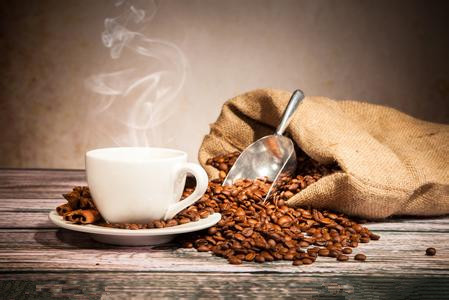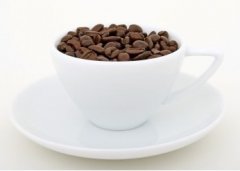Basic knowledge of coffee bean roasting Beiyi roasting

Beiyi style baking
In the case of relatively shallow baking (popular around Milan), this formula produces a cup of espresso that tastes like sugar water. Personally, I think this kind of formula is the best combination of sweetness and baked drupe flavor, but it is the most likely to cause problems in the extraction stage. The Beiyi formula has the greatest potential to produce sweet espresso, but it is very easy to screw up during extraction, thick and sweet dry aroma, which means that the flavor is the most complex and fragile, and the carbonization is relatively low. After years of practical experience, I have found that the Beiyi formula, its aromatic substances after the action of hot water, is the most fragile, if the extraction is not handled properly, it will produce "Jackyl and Hyde change". It should have a sweet smell of espresso, which may become too sour / too bitter or astringent.
As a baking retailer, when you use most of these more fragile recipes, you will face the challenge of insufficient stability in the cup when brewing. Due to the lack of baking flavor substrate in Beiyi formula, if your bar staff is a little careless, the espresso will be easy to detect defects, especially when mixed with milk; when extracted by experts, when mixed with milk, it will highlight the strong caramel flavor in espresso. To me, this caramel flavor is the style and characteristics of Beiyi formula.
Due to the low degree of carbonization of Beiyi coffee beans, it accounts for a high proportion of caramel flavor and regional flavor characteristics. It is a great challenge to retain these rich characteristics during cooking, especially in the stability of cooking water temperature. If the cooking water temperature changes too much (up and down more than four degrees Fahrenheit), the caramel flavor will be the first to be sacrificed. Then came the dull yellowish crema outflow. If the cooking water temperature is stable (the up and down change is less than 2 degrees Fahrenheit), the crema will show ochre red. But the ochre red crema does not mean that the caramel flavor can survive after brewing, even at a very stable temperature, it is often sour espresso, then the water temperature may be low (at sea level, the ideal cooking water temperature is 204 degrees Fahrenheit, the measuring point is near the coffee cake). On the thermostat in my store, I found that the sweeter the espresso, the easier it is for their crema to fall apart.
The Beiyi recipe has many other challenges for professional brewers. For example, the machine must be cleaned very carefully, because beans of the Beiyi formula are particularly easy to absorb the smell from the coffee machine. If the machine is not cleaned properly, the espresso will produce an uncomfortable bitter taste between charred toast and smelly socks after exercise. In addition, it must be stored in the shape of the whole bean and flipped and mixed from time to time. Coffee beans are stored like red wine in a sealed and opaque container at a temperature of about 55 degrees Fahrenheit. In the case of pure arabica beans, beans must be used within 3-10 days after baking, when the crema status of espresso is the most complete. If a high proportion of robusta is used in the formula, the peak of crema may be prolonged, but it must be noted that although robusta beans can provide very thick crema, it is not helpful for sweetness at all. Under the Beiyi baking degree, the vast majority of robusta beans show astringent or woody taste, while good arabica beans show sweet taste.
The bar staff must be very skilled in order to correctly cook the Beiyi formula. If there is any error in cooking or filling, resulting in the "channel" effect, the water flows quickly through this crack, the sweet molecules are destroyed, and the composition of the whole aromatic compound flowing into the cup is out of balance. Finally, the whole cup of espresso is occupied by astringency. In addition, the bar staff must also be careful not to put the espresso for too long. The cooked espresso must be mixed with milk as soon as possible. When making cappuccino, the sweet molecule of espresso is one of the important ingredients to form foam, but this ingredient will soon fade, and ceramic cups must also be preheated to preserve the espresso structure.
One of the keys to getting this seductive sweetness is the flow rate. To deal with this variable, the bar player must first carefully adjust the grinding scale. If the flow rate is too fast, it will be sour and astringent, and if the flow rate is too slow, it will be scorched and bitter. The goal of our store is to extract for 25 seconds, and the state of flow must be like a "mouse tail".
It may take years to cook a Beiyi-style espresso, but if you end up in a neighborhood where more customers like the taste, your business may be much better than other ripe bean retailers in the same community. However, if your goal is to open any type of chain store, do not choose this Beiyi-style baking, practice cooking and try to fail a lot of times, you might as well choose a deeper baking formula, customers are more acceptable. Beiyi recipe is more suitable for baking retailers interested in craftsman level to sell. A coffee lover with talent and great enthusiasm for coffee will be fascinated by the successful espresso of this Beiyi recipe. Once you have successfully mastered the main points of Peiyi recipe, then you are almost unrivalled in the industry.
Important Notice :
前街咖啡 FrontStreet Coffee has moved to new addredd:
FrontStreet Coffee Address: 315,Donghua East Road,GuangZhou
Tel:020 38364473
- Prev

The tips of ESPRESSO baking start with mixed beans
Talking about mixed beans when we talk about baking espresso beans, we are actually talking about the science of mixed beans. The highest sweet spots of all kinds of coffee beans from different countries appear at different baking points, so bakers must find a balance between baking and mixing beans in order to make a good cup of espresso. This knowledge should start with the degree of baking and the selection of beans
- Next

Coffee bean roasting in the sense of basic knowledge
Chinese baking when we bake deeper and more sugar begins to be carbonized or burned, it is called mid-baking, and this baking-degree espresso is usually popular around Florence. This kind of formula produces slightly darker beans with a bitter flavor. But the baking degree is not deep enough to burn out all the flavor characteristics of the producing area.
Related
- Beginners will see the "Coffee pull flower" guide!
- What is the difference between ice blog purified milk and ordinary milk coffee?
- Why is the Philippines the largest producer of crops in Liberia?
- For coffee extraction, should the fine powder be retained?
- How does extracted espresso fill pressed powder? How much strength does it take to press the powder?
- How to make jasmine cold extract coffee? Is the jasmine + latte good?
- Will this little toy really make the coffee taste better? How does Lily Drip affect coffee extraction?
- Will the action of slapping the filter cup also affect coffee extraction?
- What's the difference between powder-to-water ratio and powder-to-liquid ratio?
- What is the Ethiopian local species? What does it have to do with Heirloom native species?

